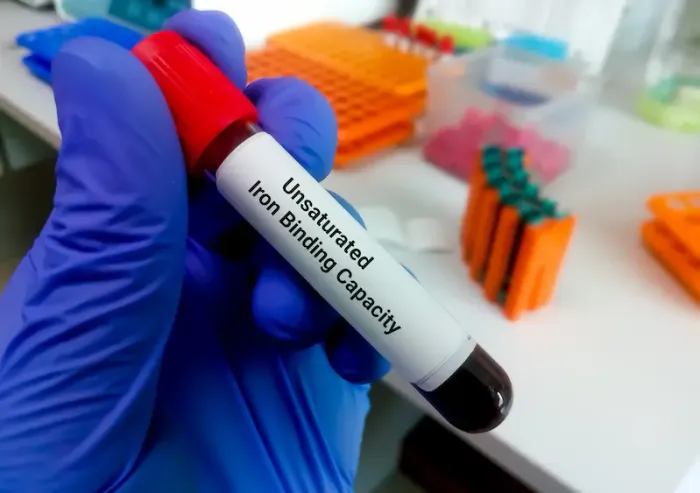Understanding Total Iron Binding Capacity Test
Explore the Total Iron Binding Capacity (TIBC) test, its purpose, and what the results reveal about your iron levels. Learn how this test aids in diagnosing iron deficiency and related conditions.

Written by Dr. Dhankecha Mayank Dineshbhai
Reviewed by Dr. Md Yusuf Shareef MBBS
Last updated on 25th Aug, 2025

Iron is an essential mineral that plays a vital role in our body, helping produce red blood cells, transport oxygen, and maintain energy levels. However, too much or too little iron can cause health problems. The Total Iron Binding Capacity (TIBC) test helps doctors understand how well your body manages iron.
If you've been advised to take a TIBC test or are curious about what it means, this article will explain everything in simple terms.
What is a TIBC Test?
The TIBC test measures how well your blood can transport iron. It checks the capacity of a protein called transferrin, which carries iron in your blood. A high or low TIBC level can indicate iron-related disorders like anemia or iron overload.
This test is often done alongside other iron tests, such as:
• Serum Iron Test – Measures iron levels in your blood.
• Ferritin Test – Checks iron stored in your body.
• Unsaturated Iron Binding Capacity (UIBC) – Measures how much transferrin is not yet bound to iron.
Together, these tests help diagnose conditions like iron deficiency anemia or hemochromatosis (excess iron).
Consult a Top Hematologist
Why is the TIBC Test Done?
Your doctor may recommend a TIBC test if you have symptoms like:
• Fatigue or weakness
• Pale skin or dizziness
• Shortness of breath
• Irregular heartbeat
• Joint pain or abdominal discomfort
It helps determine if your symptoms are due to:
• Iron deficiency anemia (low iron)
• Hemochromatosis (too much iron)
• Chronic diseases affecting iron levels
How is the Test Performed?
The TIBC test is a simple blood test:
1. A healthcare professional will draw blood from a vein in your arm.
2. The sample is sent to a lab for analysis.
3. No special preparation is needed, but fasting may be required in some cases.
Get Your Health Assessed
Understanding Your TIBC Test Results
Normal TIBC levels range between 240–450 mcg/dL (micrograms per deciliter), but this can vary slightly between labs.
High TIBC Levels
• Possible Cause: Iron deficiency (your body tries to absorb more iron).
• Symptoms: Fatigue, weakness, pale skin.
• Next Steps: Your doctor may suggest iron supplements or dietary changes.
Low TIBC Levels
• Possible Cause: Excess iron (hemochromatosis), inflammation, or liver disease.
• Symptoms: Joint pain, fatigue, darkening skin.
• Next Steps: Further tests or treatments to reduce iron levels.
How to Manage Abnormal Iron Levels
If You Have Low Iron (Iron Deficiency Anemia)
• Eat iron-rich foods: Spinach, lentils, red meat, beans, and fortified cereals.
• Vitamin C helps absorption: Pair iron-rich foods with oranges, tomatoes, or bell peppers.
• Avoid calcium/tea with meals: They can block iron absorption.
• Supplements: Only take iron supplements if prescribed by a doctor.
If You Have High Iron (Hemochromatosis or Iron Overload)
• Avoid excess iron: Limit red meat and iron-fortified foods.
• Donate blood regularly: Helps reduce excess iron (if approved by your doctor).
• Avoid vitamin C supplements: They increase iron absorption.
• Medication or therapy: In severe cases, doctors may recommend treatments to remove excess iron.
When to See a Doctor
If you experience symptoms like extreme fatigue, dizziness, or unexplained joint pain, consult a doctor. The TIBC test, along with other iron tests, can help diagnose the issue early.
Book a Test or Consultation with Apollo 24|7
If you need a TIBC test or expert advice on iron-related concerns, you can:
• Schedule a blood test at home or a nearby lab.
• Consult a doctor online for personalized guidance.
Early detection and proper management can help maintain healthy iron levels and prevent complications.
Final Thoughts
The TIBC test is a useful tool to check how your body handles iron. Whether you have too little or too much iron, simple dietary changes and medical guidance can help restore balance. If you suspect an iron-related issue, don’t hesitate to get tested. Your health matters, and understanding your iron levels is a step toward feeling your best!
Consult a Top Hematologist
Consult a Top Hematologist

Dr Ankit Kumar
Haematologist
8 Years • MBBS, MD(Pathology), DM (Clinical Haematology)
Gurugram
The DermHaem Clinic, Gurugram

Dr.sanchayan Mandal
Medical Oncologist
17 Years • MBBS, DrNB( MEDICAL ONCOLOGY), DNB (RADIOTHERAPY),ECMO. PDCR. ASCO
Kolkata
Dr. Sanchayan Mandal Oncology Clinic, Kolkata

Dr. Sonal Paul
Haematologist
9 Years • MBBS, MD Pathology, DM Clinical Haematology
Kolkata
SATKRIT HEALTHCARE - A MULTISPECIALITY CLINIC, Kolkata

Dr. Thorana Prakash M
General Physician
2 Years • MBBS
Bengaluru
PRESTIGE SHANTHINIKETAN - SOCIETY CLINIC, Bengaluru

Dr. Sushith C
General Physician
2 Years • MBBS
Bengaluru
PRESTIGE SHANTHINIKETAN - SOCIETY CLINIC, Bengaluru
Consult a Top Hematologist

Dr Ankit Kumar
Haematologist
8 Years • MBBS, MD(Pathology), DM (Clinical Haematology)
Gurugram
The DermHaem Clinic, Gurugram

Dr.sanchayan Mandal
Medical Oncologist
17 Years • MBBS, DrNB( MEDICAL ONCOLOGY), DNB (RADIOTHERAPY),ECMO. PDCR. ASCO
Kolkata
Dr. Sanchayan Mandal Oncology Clinic, Kolkata

Dr. Sonal Paul
Haematologist
9 Years • MBBS, MD Pathology, DM Clinical Haematology
Kolkata
SATKRIT HEALTHCARE - A MULTISPECIALITY CLINIC, Kolkata

Dr. Thorana Prakash M
General Physician
2 Years • MBBS
Bengaluru
PRESTIGE SHANTHINIKETAN - SOCIETY CLINIC, Bengaluru

Dr. Sushith C
General Physician
2 Years • MBBS
Bengaluru
PRESTIGE SHANTHINIKETAN - SOCIETY CLINIC, Bengaluru

